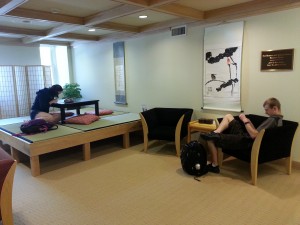Four students from “Climate Change, Rivers, and Chinese Society,” a course taught by Professor Ann Hill and LIASE Postdoctoral Fellow Kelin Zhuang, presented posters at the Asia/Environment Student Research Conference, which convened at Bard College, April 16-17, 2015. Learn more about their presentations here.
Category Archives: Uncategorized
Post-Doctoral Fellow in East Asian Studies in the Environment
Luce Initiative on Asian Studies and the Environment
Dr. Zhuang Kelin, a post-doctoral fellow supported by the Luce grant, is soon to come to Dickinson College to teach about paleoclimatology, including climate change and river systems in China. Professor Zhuang is from Qingdao and has a PhD from Texas A&M. He will be teaching ERSC311-01 Paleoclimatology of East Asia as a one-time only course in the Fall of 2013. The course is interdisciplinary and has no prerequisites.
Renovations to the Stern Center Lounge
Luce Initiative on Asian Studies and the Environment
Recent renovations to the Stern Center basement have left students with a beautiful, Japanese style lounge. The lounge features elements of feng shui, and contains tatami floor mats, an elevated seating platform, a stone fountain, the game GO!, and an expansive six panel painted screen, depicting an old Japanese tale.
The Screen
Luce Initiative on Asian Studies and the Environment
Recent renovations to the Stern basement have found this screen enjoying new celebrity as the centerpiece of the new Japanese lounge. Complete with grass mats and a stone fountain, this space new space exhibits this beautiful piece in feng shui alignment.
From “New Lives for Asian Images,” by Professors David Strand and Samuel K. Parker:
Court ladies in colorful kimonos are shown enjoying an outing in early spring. According to Professor Alex Bates, this screen, in Yamato-e style, is a copy of the Sumiyoshi monogatari emaki, a Kamakura period picture scroll. The upper half of the painting, including gold cloud formations, was added by the artist to extend the vertical dimension in a manner appropriate to a screen. The original scroll tells the story of a young girl, Himegimi, whose stepmother threatens her marriage prospects. In the scenes depicted here, Himegimi and her entourage are picking young pines in a ritual celebrating spring. An aristocrat of the Shosho rank discovers Himegimi’s beauty despite the efforts of the step-mother to hide her away. As he spies upon Himegimi (from the lower left of the panel), the young man composes a poem:
The spring mists,
veiled the moor,
Yet I went out
and glimpsed this day
the young green of the pine
The Shosho alludes to the difficulty of seeing Himegimi and compares the beauty of the maiden to that of the young pines. Nature imagery conveys meaning in a fashion characteristic of classical Japanese poetry. The placement of male and female figures creates a strong impression of gendered space and emphasizes the transgressive nature of the Shosho’s gaze.
The size and design of his screen suggests that it was once owned by a wealthy Edo merchant. Incoking an aristocratic culture pre-dating samurai rule, the artist and his patron celebrate an ancient, golden age of taste and refinement imagined to outshine the Tokugawa present.
The Vase Project
Luce Initiative on Asian Studies and the Environment
Turns of the Wheel/Strokes of the Brush: Landscapes and Cityscapes
In a Changing Chinese Environment: The Jingdezhen Vase Project
In her much-praised The Vase Project Professor Diduk asked one hundred local Jingdezhen artists to each paint one white porcelain vase. Each artist was given a blank vase and asked to respond to the preceding artist painter’s vase. They were asked to interpret the vase imagery, incorporating their own individual painting styles in the pieces, but not to copy it, since mimetic copying is the usual painting method practiced. The first painter in the Project responded to a small drawing that incorporated kiln stacks along with the always familiar historical landscape image. In this case the inclusion of manufacturing was intended to reflect the current contemporary scenic landscape in Jingdezhen today. Taken as a kind of ceramic quilt or kaleidoscope, the vases help viewers see what the city was like before and during modern industrialization and the process whereby artists shifted their attention from imperial and scholar-elite or merchant patrons as customers to hotel chains in need of crockery, foreign tourists in search of China’s past, and Chinese consumers trying to keep up-to-date in a rapidly changing material culture. As her collaborative project demonstrates the ongoing evolution of the city in its environmental policies (switching from coal-fired to propone kilns for example) proves, there is a forward-leaning outlook among Jingdezhen artists, activists and ordinary residents even as the community struggles to preserve Jingdezhen’s artistic legacies. The city that produced The Vase Project is in the throes of transitioning from a rugged, dirty, small manufacturing center consisting of workshops and smallish factories, into up-to-date manufacturing facilities and a center of modern ceramic art. The waning of ceramic making traditions in Jingdezhen is best understood both in global context (this is not the first time that craft traditions have been reshaped by new markets, technologies and artistic sensibilities and health and environmental concerns) and the local realities that contribute to such powerful turns of history in unique, culturally colored and inflected forms.
In the summer of 2015, a group of students will travel to Jingdezhen on a study-trip, which will provide even more critical insight into the culture surrounding ceramics in Jingdezhen.

